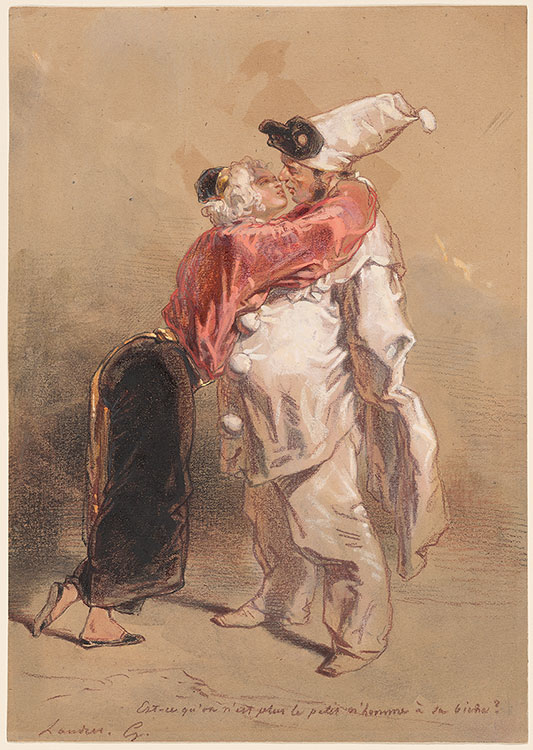

Paul Gavarni was the nom de plume of Sulpice Guillaume Chevalier, a Parisian who started life as an engineer's draughtsman but soon became a caricaturist and illustrator. His better-known work appeared in Le Charivari, though some of his most acerbic drawings appeared in L'Illustration after a visit to London.
This sheet is inscribed London, where Gavarni worked in 1847 and 1851, producing extensive series of drawings. It belongs to a larger group of drawings featuring men and women in masquerade costumes exchanging quips. At carnival time, a man in the traditional costume of Punchinello from the commedia dell'arte (which was then called “Domino” in England) asks of his female companion, a singer dressed in wide trousers, a gold sash, and a short red jacket, “'Est-ce qu'on n'est plus le petit n'homme à sa biche?” or “Are we no longer the little man and his doe?”
Other sheets with similar scenes of erotic play, such as one in the Walters Art Museum, Baltimore, dated December 1847 and also inscribed “Londres” (37.1461). He published some of his compositions as lithographs in 1849's “Gavarni in London,” and a further collection appeared after his return to France when he began to publish almost a lithograph a day in a continuing series called “Masques et Visages” that appeared in the periodical “Le Paris.” These works combined close social observation, compassion for the working classes, and a certain wry, bitter humor. While this scene does not appear to have been published in the 1840s, the young female character in male dress appears in other scenes from the decade. One published scene from 1841, with the young woman, is captioned “Et vos pauvre femmes? Affreux gueux!”, while another from around 1850 is an amourous scene captioned “As-tu dejeune, Pierrot?”
Inscribed and signed in red chalk at lower center: 'Est-ce qu'on n'est plus le petit n'homme à sa biche? / Londres. G.'
Seligman, Germaine, former owner.
Winzinger, Franz, 1910-1983, former owner.
Olson, Roberta J. M., former owner.
Johnson, Alexander B. V., former owner.
